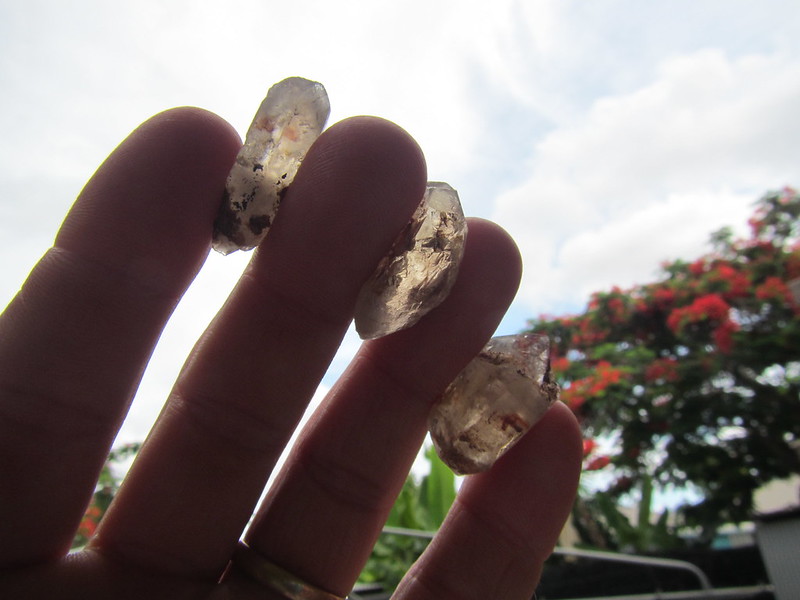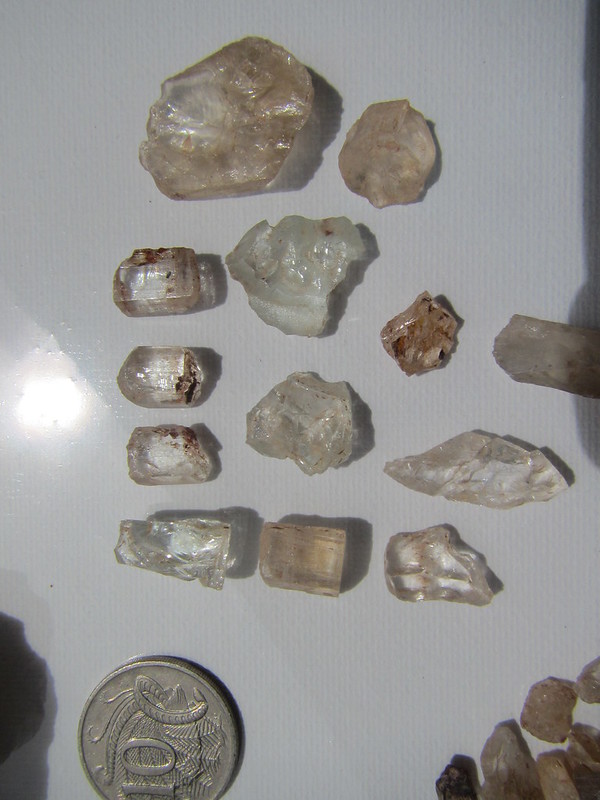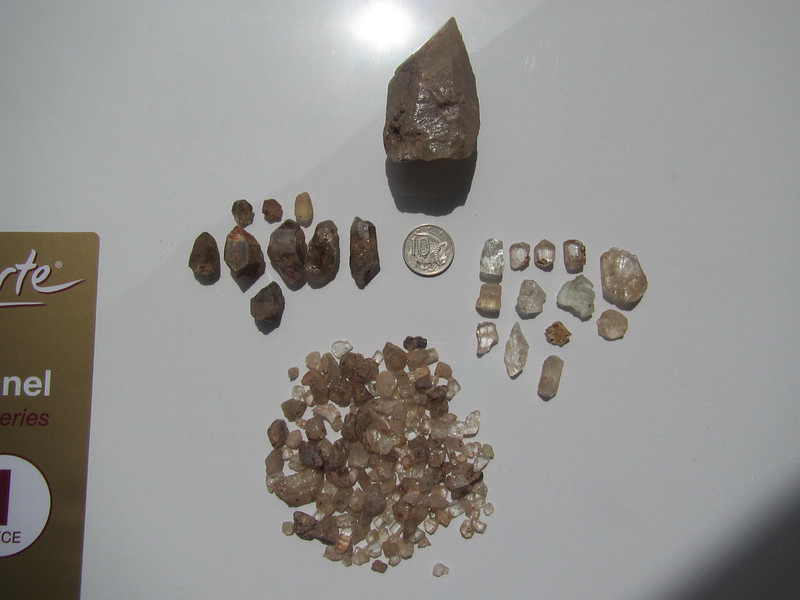THE FORMATION OF QUEENSLAND SAPPHIRE RESOURCES - AN ALTERNATIVE THEORY!
BACK TO GEOPHYSICS INDEX
Taken from an address by Jim Elliot at the Central Queensland Gemfest 2003
The conventional theory has it that the formation of the Central Queensland and the Lava Plains sapphire resources is the result of major extrusions or emissions from large volcanic sources and that the sapphire was subsequently transported by large river systems and deposited in the areas where it is currently mined today.
As a result of observations during some 20 years of mining on the Central Queensland Gemfields and 5 years on the Lava Plains field, I believe this theory to be totally incorrect.
I believe that the sapphire was produced from a large number of smaller vents which are located throughout the sapphire producing areas, and that the sapphire never moves, any significant distance from its point of origin at the surface.
I believe that the term ''water worn sapphire" and, to a large extent, "water worn billy boulders and rocks" are similarly incorrect and that any wearing or rounding took place in the process of formation, and not as a result of alluvial transportation.
I provide the following information in support of my theory and as reasons why I found it necessary to look for a different method of formation than the one which has been generally accepted in the past.
a. We have found tremendous variation in the quality and nature of not only the sapphire within very short distances, but also of the associated ironstone and silcrete (billy boulders).
b. When trying to follow the "sapphire river system" in any area, we found that :: were constantly coming out of one type of mining terrain and going into other where the inherent characteristics of the material changed.
c. We found as many as three overlying wash layers with totally different types of sapphire and ironstone, and the directions of deposition varied widely and could not be related to surrounding areas.
d. We started to mine at Lava Plains, our preconceived ideas failed us and we had difficulties in locating and understanding the sapphire deposition and formation patterns
We tried some mining techniques which would have had conventional miners questioning our sanity - but they worked, and we found sapphire! We left the alluvial systems and started mining the huge deposits of volcanic ash which blanket the area - and we found excellent sapphire.
We stripped off layers of lava flow rock to expose further layers of volcanic ash below - and again we found more sapphire.
We then moved away from the small source vents which produced the material and the quantity and quality of sapphire decreased quite quickly as we moved away - despite the presence of significant alluvial beds, so the river transportation theory was losing its appeal to us.
We then moved back to the alluvial beds in the area closer to the vent sources, and found bulk Sapphire - but again the quality varied quite quickly when we moved from one vent area to another even though they were only a few hundred metres apart.
e. We came back to the C.Q. Gemfields and looked at our mining in a new light, looking for evidence of small localised deposits - and the evidence was everywhere.
f. We looked at the current major river systems like Retreat Creek, which flows past the major volcanic peaks which we had always been told were the source of all our sapphire.
However, when one analysed the sapphire from the various mining areas down the course of Retreat Creek, the material had distinct changes at least 6 times in the length of flow through the Gemfields area.
Having thought about all these variables, and with my trusty divining rods in hand, I went back over many of the mining areas which-had been "worked out" as a result of the mining over the 125 years of the field's history.
I identified many, many small source vents, and it became apparent that many of these vents must have had several stages of production and that, as a result, there would be several layers of wash from the one source in many cases.
This enabled me to direct some hardworking hand miners into areas which older hands said were totally mined out - but the current hand miners have gone further down and found good, bearing wash as a reward for their efforts.
I provide some thoughts on currently held ideas for consideration by learned and qualified geologists and gemologists..
1. "Water Worn Sapphires"
Every rockhound knows that if you put a sapphire crystal in a tumbling machine with grinding compound and let it run for even I0 weeks the sapphire will probably still have it's corners still visible. If you do the sum for a 500mm diameter tumbler doing 40 revs per minute, for 60 mins/hour, 24 hrs/day, 7days/week, for 10 weeks - you will find that your sapphire has traveled some 6,000 kilometres in a dry abrasive environment - but is still not reduced to a round pebble.
How is it formed then? I believe that the pebble is formed by the rounding of the sapphire crystal in the vary high temperature and the very aggressive environment in the 'formation tube' during the passage from the formation zone some 65 kilometres below the surface.
It will be noticed that many of these rounded sapphire pebbles have a surface which is severely pitted with small pinhole craters - whereas, if they were stream worn they would have smooth surfaces.
This pitting is the result of the explosion of small dots of rutile just below the surface of the sapphire crystal. It the temperature is below the melting point of sapphire, but above the volatilisation point of rutile, the escape of the volatilised rutile will pit the softened surface, but rutile further below the surface will be captured by the skin tension and will be absolved or reconverted within the sapphire.
2. "Water Worn" Billy Boulders.
I do not believe that the smooth surface of billy boulders is due to any form of stream polishing, but is again the result of rounding and glazing in the aggressive 'formation tube' environment.
Every miner has seen billy boulders with holes right through them and with deep crevices and holes - and they are always polished, even in these hard to get at locations - so this cannot be from stream wear.
3. Shape of Sapphire Crystals.
Conventional wisdom has it that sapphire forms in the shape of double-terminated "dogs teeth", or at very least a single dogs tooth form.
Having studied tens of thousands of pieces of sapphire from out mining operations, Jenny can assure you that very little of the sapphire found is actually broken, and that most of the pieces actually are the entire crystal as it was formed.
This "as formed" crystal shape can be chunky, but irregular, or flat like a sapphire platelet - but they all are fully developed crystals without being broken off a larger piece. Many miners, when finding a large piece which is apparently the broken-off centre section of a dogs tooth have been known to exclaim that they wish that they could find the rest of the crystal - when , in reality, they do have the entire crystal.
While many people believe will undoubtedly say "who cares?", we believe that the proper recognition of the formation and type of sapphire is relevant and important for the survival and development of our industry.
If new miners look at many of the old "mined out" 6reas in an un-prejudiced light, I believe that they will find that there are still very large reserves of sapphire to be tapped - not only on the existent sapphire mining areas, but throughout the rest of Australia.
These as-yet undiscovered new areas of commercial significance may not be of the same scale as New England, Central Queensland or Lava Plains - but they will each have their own characteristics and could well play a major part in both the recognition and the marketing of Australian sapphire.
Australian sapphire has suffered in the past because of the domination of the world markets, principally by the Thai dealers and factories. As a direct result of their deceitful practices in taking the major portion of our rough back to Thailand for heat treatment and cutting, and later reselling the best of our sapphire as being "Thai" or "'Ceylon" sapphire, the world has not been allowed to recognise the true high quality and amazing colour range of Australian material.
This Thai domination is rapidly coming to an end, and the rapid collapse of their control is largely due to their own continuation of deceitful practices. The selling of huge amount of chemically modified beryllium treated sapphire to unsuspecting regular clients without telling them what the material really was, has destroyed a lot of confidence in the Thai cutting industry.
Australia now has a great opportunity to be recognised finally as a major world player in the sapphire industry - as a supplier of high quality, genuine, natural, unadulterated material.








